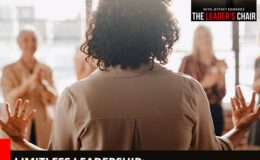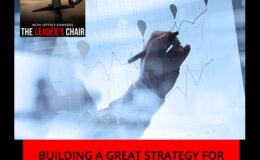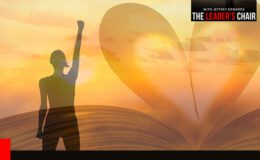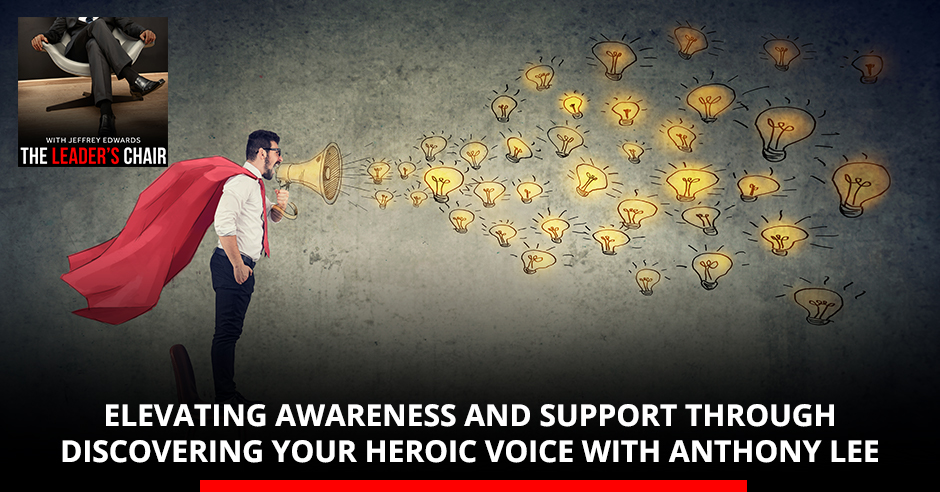
A study by LinkedIn shows that one of the top skills required in the workplace is oral communications. But for many leaders, taking to the stage is still a challenge — let alone keeping people awake and engaged during their presentation!
In today’s podcast, I got to speak with Anthony Lee about discovering your heroic voice in leadership so you can deliver your best presentation, as well as elevating your support and reputation within your organization.
About Anthony Lee
 Anthony Lee is the Founder of the Heroic Voice Academy, a communications training company. In his professional career, he helps leaders develop their heroic voices to solve global challenges.
Anthony Lee is the Founder of the Heroic Voice Academy, a communications training company. In his professional career, he helps leaders develop their heroic voices to solve global challenges.
The Heroic Voice Academy has prepared clients for their high stakes presentations, including conference keynotes, TEDx presentations, conference trainings, investor presentations, and media interviews. Their clients have made a significant impact in the areas of animal welfare, entrepreneur education, early disease diagnosis, re-engineering our schools, ending human trafficking, and curing Alzheimer’s Disease.
Check out this episode if you want to learn:
- What makes athletes, musicians and people in the military well-suited to public speaking
- What the ‘energetic triangle’ is — and how to use it to your advantage
- Why vulnerability makes for compelling speeches
🎧 Listen to the podcast here:
‘Discovering Your Heroic Voice’ With Anthony Lee
What inspired you to start the Heroic Voice Academy?
I’ve been in technology for the majority of my career, and one of my favourite things to do is to teach engineers how to present to non-technical people. If I can teach an engineer how to speak well, I can do that for anyone!
Back in 2014, I was invited to train a group of TED speakers for the stage: a tremendous group of global impact leaders. There is the kind of training where we have to drag (clients) to the finish line. Another type of training (is) where the students are all-in, because they’re motivated. They are totally dedicated to a mission — and that’s what made a light bulb click in my head. If I can talk to these clients — those that are committed to global impact — that could be the rest of my career. If I can have everyone be able to speak well on behalf of their mission of global impact, I want to live. That was the turning point in how I took presentation skills to a specific audience.
It sounds like you were bridging your passion for social good with your technical experience. What have you seen unfold from your work over the years?
There’s a study by LinkedIn where they cover which top skills that are going to be required going forward. The skills gap that they always identify is oral communication. Presentation skills aren’t something that’s formally taught in schools, nor is this something that we carve out time for. If leaders aren’t (able) to present well, they have to adopt better practices. Who do we look to for these practices?
In looking at our most successful clients, we found some interesting things about their background: number one, they have been in competitive sports. Number two, they’ve been in performance arts — dancers, musicians, etc. Number three, they served in the military. The key thing there is that they all have a lifestyle of practice.
The athlete would never go into a competition without practice. The dancer and musician would never take the stage without practice. The soldier would certainly never take to the field of battle without drills and practice. That’s the secret. How do we instill this lifestyle of practice into the voice of all of our leadership?
'The back of a napkin is where a lot of ideas are born.' Click To TweetA powerful presentation is about more than simply saying the words — it’s about inspiring people, and you help people develop that.
There is an energetic triangle that exists in a room. The presenter is point one of the triangle, the audience is point two, and the presentation is point three. Looking at this as a triangle, I can easily determine if the presenter is connected to their message. If the presenter is also well-connected to the audience, then the audience connects well to the message.
There are specific tools and skills that can help you strengthen each one of these connections, and that’s what we focus on: evaluating a presentation, and coaching people on how to connect better with their audiences.
How is working with social entrepreneurs different to working with leaders in other fields?
Global impact leaders have a clear vision of the world that they’re creating, (and) that’s different than a standard C-suite executive for a Fortune 500 company. One of the clients that I coached back in that 2014 TED Talk was the CMO of an organization called the ‘Best Friends Animal Society’. They’re one of the leaders in the no-kill movement. When they started, their vision was to go from 17 million dogs and cats being euthanized every year in America, and bringing that to zero.
For them, the vision is quite clear: every dog and cat in a shelter finds a ‘forever home’. That’s the difference in working with this demographic: they have a clear vision of where they’re taking their community. When they go on stage, they don’t know how to communicate that vision, or (convince) the audience into supplying money, donations, support in the form of partnerships — or even (increasing their) reputation.
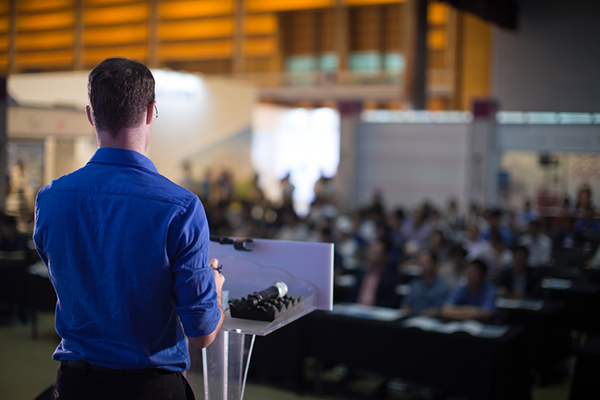
Discovering Your Heroic Voice: If the presenter is connected to their message and the audience, then the audience connects well to the message.
What about for entrepreneurs pitching to investors? They’re clear on their numbers and what they need — but what do you find that they’re lacking in their presentation?
With the pitch deck, I pitch a great idea, how it’s going to change the world, and how much money we’re going to make together. The element that’s lacking is the personal side. The one question that the investor or any venture capital partner has is: ‘how can I count on you?’ How can I count on you to work 18-hour days, when it’s necessary for you to stand tall in times of adversity? Investors invest in the person first, the idea second.
Who are you as a person? Where are you going? What’s most important to you? How can I count on you? Answer those questions with an investor or with a VC partner, then you’re getting a conversation.
This is something that you can apply to any conversation or presentation. ‘Where are you going?’ That’s an expression of your vision. ‘What’s important to you?’ That’s an expression of your values. ‘How can I count on you?’ That’s an expression of your vows. Any speaker — whether they’re in front of one person, or in front of a huge audience — if they answer those three questions, they’re in great shape.
There are a number of different public speaking organizations. Which services would you recommend?
Toastmasters or Dale Carnegie are great places to start. They’ll tell you how to sequence your ideas, and you get good practice at developing your passion for sharing (your) expertise. Then there are advanced tools that you’re ready for after you’ve done your work with Toastmasters or Dale Carnegie. How can you, as a speaker, better connect to your audiences? Those are skills that we call relatability and empathy. How can your message better connect to your audience? That’s comprehension and engagement.
What advice do you have for someone who’s not even sure they have anything worth sharing with an audience?
There’s an exercise that we have in our training, (where you) pretend that you’re a time traveler. I want you to go forward in time. Go to a location where you can use your phone, and take one picture. That picture is supposed to be evidence that, whatever (your) mission was, (your) made it.
That exercise is so much fun because it allows (clients) to use their creative mind, to get on a piece of paper and sketch, ‘this is a vision of what I’m creating.’ Once they do that, they (share) it to anyone who wants to join their team, or to donate or invest in it.
It’s a skill that all of have — when we were five years old, we had Show and Tell. We didn’t need to have any presentation skills — we took something that we were interested in and we shared it with the class. It’s giving (clients) a meaningful exercise to reinstall the confidence that existed in them when they were five.
'If the audience know what's going on in your head, they're going to be behind you and continue rooting for your success.' Click To TweetI would think that it helps to take something that’s in their head and getting it on paper. It becomes real for them: ‘This is what I’m doing. This is how I’m impacting people.’
One of my mentors, Dan Roam, has a book called The Back Of The Napkin. (If) we’re sitting somewhere and (we get a) brilliant idea, we sketch it on the back of a napkin, so that we can refer to it later, or show it to the person in front of us. There is nothing more needed than shapes or stick figures to communicate an idea. All of us have this capability, and I believe it’s the most powerful way to start. In Dan’s book, there are a lot of great tips on how to get started with this one tool of visual communication.
When you put it that way, it sounds simple — so why is public speaking so debilitating for some people?
There’s a set of beliefs that we bring on stage. The right set of beliefs set you up for success. The other set of beliefs create the experience you just described: ‘I have to deliver it perfectly, I have to stick to a script’ — that doesn’t set you up for success. The set of beliefs that are powerful are, ‘I’m going to go on stage, and I’m going to treat it like a coffee shop conversation, or a conversation in my living room.’ The audience is going to appreciate that much more. When that mindset is present, you’re more present.
There are mistakes in conversation. In a conversation like this, I would never say, ‘Jeffrey, let me read my script so I can give you a response.’ That’s ridiculous, but we make up that we have to do that on stage. Once you take the stage, knowing that it’s your living room or you’re in a coffee shop — you tend to relax, and you’re always connected with the person in front of you.
I would think part of the hesitation is also because of vulnerability. It’s fine if we’re a couple of people in a coffee shop, but I’m not going to have a coffee with 500 people in front of me!
We had a gentleman named Bassam in one of my TEDx trainings. When he was speaking at TEDx, he did something that I’ve never seen before: Bassam goes on stage and he starts his presentation the way that we rehearsed. He gets to the third sentence, and he trips over himself. Instead of continuing on, he says, ‘I’m going to go off stage, and we’re going to take this from the top. I am a bit nervous. I want to give a fresh start. Is that okay?’ He went off stage. I’ve never seen this. (Then) he came back on stage, and delivered a wonderful presentation.
When the audience sees that, they think, ‘It’s OK to make mistakes on stage. He’s just like me. I have permission to do that as well.’ Let your audience see your vulnerability: ‘I’m a little bit nervous. Let me take a breath and make sure that I’m fully present here with you.’ Any number of tools can help you shift yourself, and let the audience know what’s going on in your head. They’re going to be behind you. They’ll continue rooting for your success.
If you’re able to deliver a message and it changes one person’s mind, you’ve made a difference, haven’t you?

Discovering Your Heroic Voice: We all have within us the ability to draw and to do public speaking since we were five years old. We just have to reinstall the confidence that existed when we were five.
How I presented, the number of mistakes I made — it doesn’t matter, because I changed the trajectory of someone’s life in that room. That’s what keeps me grounded. That what I recommend that any speaker, any teacher do to keep themselves grounded.
As you’ve helped others develop their voice, what have you learned about your own voice, your leadership style and approach to life?
I grew up with a Chinese upbringing. One of my grandparents had given us our Chinese name, and this honour fell to my dad’s mom. She chose for me two characters. These characters never made sense for me — the first character means country, the second means health. ‘Healthy Country’ — what does it have to do with me?
In the Chinese language, you’re not intended to take each character and reverse-engineer it to have a strict definition. What they’re meant to do in collaboration is to be abstracted. It occurred to me, as I’ve been doing this training, that she was right on target when choosing this name for me. These are two values: community and empowerment. What I’ve been doing all this time is bringing communities together and helping them express their voice. To me, that’s a healthy expression of who we are and what we stand for.
That was the connection I made. My grandma gave me a name, and I finally realized that I’ve lived up to the name that she gave me. That’s my biggest learning.
📌 Important Links:
Love the show? Subscribe, rate, review, and share!
Join The Leader’s Chair Community today on Facebook and Twitter.

